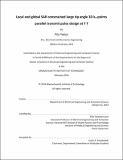Local and global SAR constrained large tip angle 3D kT̳-points parallel transmit pulse design at 7 T
Author(s)
Yetişir, Filiz
DownloadFull printable version (3.304Mb)
Alternative title
Local and global specific absorption rate constrained large tip angle three-dimensional knowledge translation-points parallel transmit pulse design at 7 Tesla
Other Contributors
Massachusetts Institute of Technology. Department of Electrical Engineering and Computer Science.
Advisor
Elfar Adalsteinsson.
Terms of use
Metadata
Show full item recordAbstract
In the last decade, there has been a push towards higher main field strengths in magnetic resonance imaging (MRI) to achieve better contrast and higher signal to noise ratio (SNR). A drawback to current imaging systems at high field is transmit magnetic field inhomogeneity, which degrades both SNR and contrast. This inhomogeneity can be mitigated through radio frequency (RF) pulse design with conventional single-channel RF systems, but at the cost of impractically long pulses. Parallel transmit (pTx) systems with multiple independent and simultaneous RF transmit channels achieve transmit field inhomogeneity mitigation with practical pulse duration, but with potentially higher deposition of RF energy as measured by the specific absorption rate (SAR). In addition, RF pulse design becomes a more challenging task with pTx systems. The electric fields of independent channels can constructively interfere (linearly add up) at points in the body and create local hot spots, whose effect is quantified by local SAR. The peak local SAR inside the body needs to be kept under specified safety limits, hence a large number of constraints are forced upon the RF pulse during the design process. In order to avoid a large number of constraints which complicate and slow down the pulse design, it is possible to limit local SAR indirectly by limiting the RF pulse power. Although this approach results in a simplified and faster RF pulse design process, it is not optimal because pulse power and local SAR are not linearly related. At small tip angles (low RF energy deposition) with spokes trajectory, it has been demonstrated that the control of pulse power does not explicitly control local SAR and simultaneous constraints of pulse power and local SAR are required to yield optimal pulses satisfying system and regulatory limits. At large tip angles (high RF energy deposition) the local SAR constraint is more restricting for RF pulse performance relative to the small tip angle case. Therefore, the ability to design optimal RF pulses for the same constraints becomes more crucial at large tip angle regime. To our best knowledge, none of the existing large tip angle pTx pulse design methods are capable of controlling local SAR directly. In this thesis the small tip angle approach is extended to large tip angle and local SAR, global SAR and pulse power constraints are explicitly incorporated in the design of 3D kT-point large tip angle RF excitation pulses at 7 Tesla. It is demonstrated that the excitation fidelity of the large tip angle pulses improves significantly when local SAR constraint is imposed directly instead of indirectly via control of the peak RF power.
Description
Thesis: S.M., Massachusetts Institute of Technology, Department of Electrical Engineering and Computer Science, 2014. This electronic version was submitted by the student author. The certified thesis is available in the Institute Archives and Special Collections. In title on title-page double-underscored "T" appears as subscript. Cataloged from student-submitted PDF version of thesis. Includes bibliographical references (pages 65-66).
Date issued
2014Department
Massachusetts Institute of Technology. Department of Electrical Engineering and Computer SciencePublisher
Massachusetts Institute of Technology
Keywords
Electrical Engineering and Computer Science.